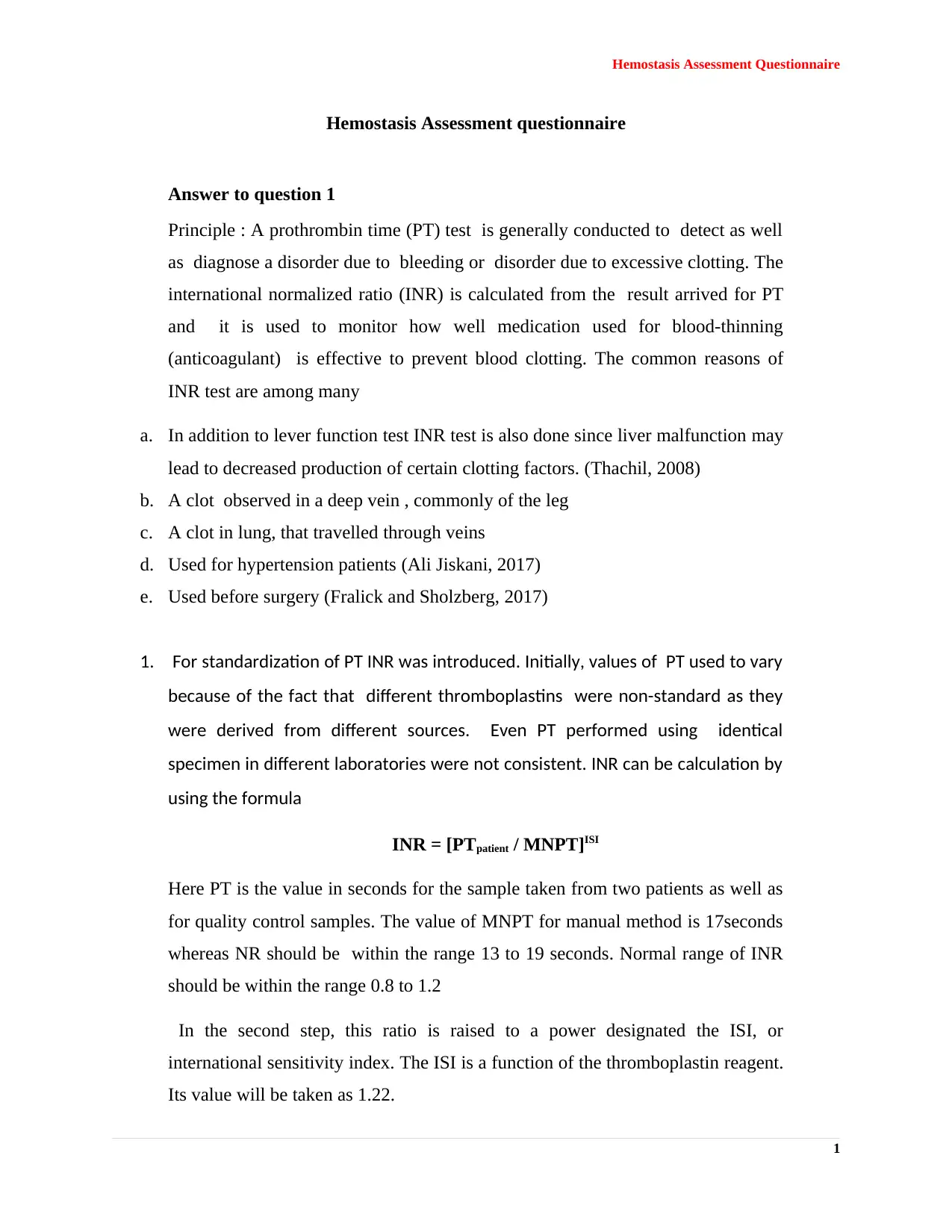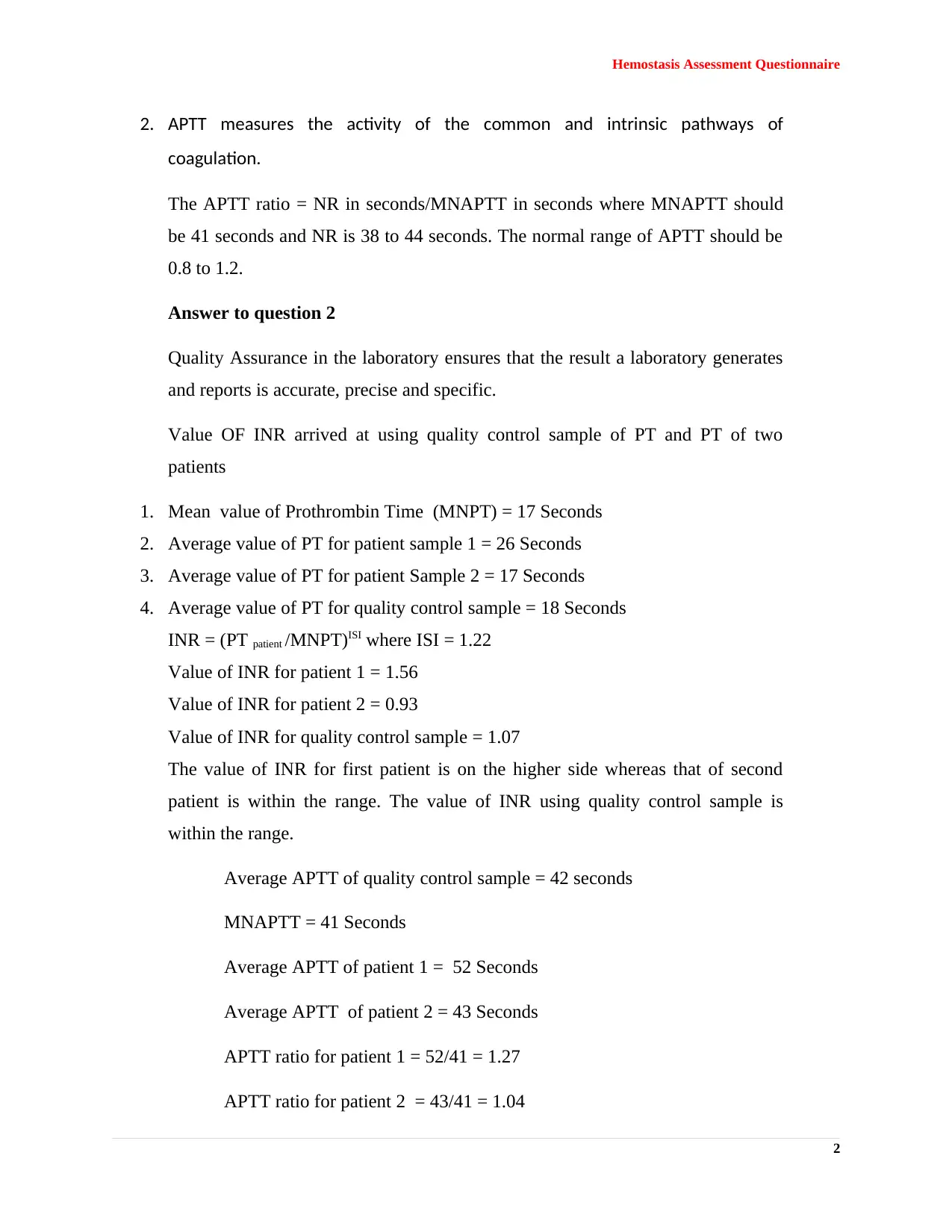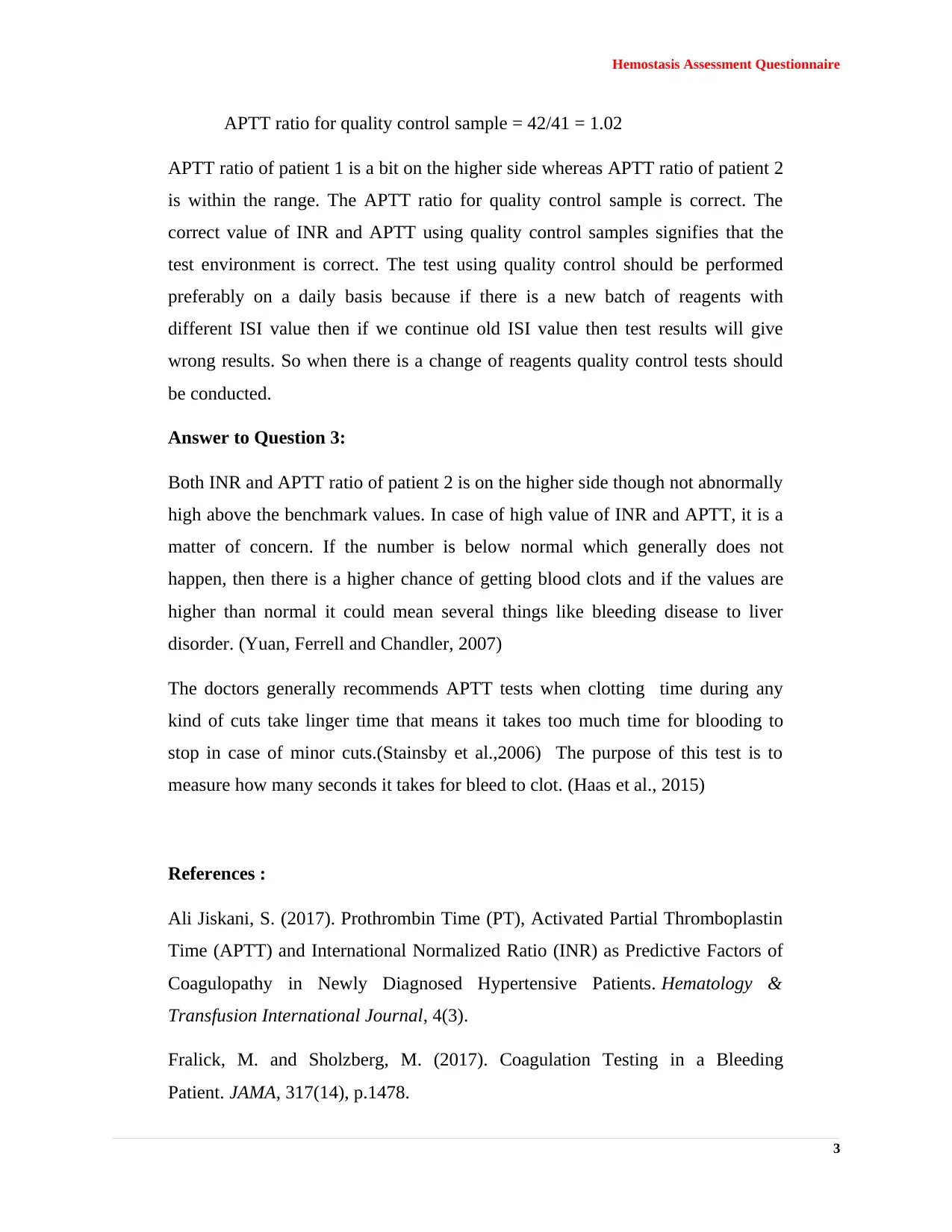Hemostasis Assessment Questionnaire: INR, APTT, and Quality Control
VerifiedAdded on 2023/04/25
|4
|1166
|96
Homework Assignment
AI Summary
This assignment analyzes a hemostasis assessment questionnaire, focusing on the interpretation of prothrombin time (PT), international normalized ratio (INR), and activated partial thromboplastin time (APTT) tests. The document provides a detailed explanation of the principles behind PT and INR, including their standardization and clinical applications, such as monitoring anticoagulant therapy and assessing liver function. It then presents a quality assurance analysis, calculating INR and APTT ratios for patient and control samples. The analysis includes the importance of quality control in laboratory testing, emphasizing the need for regular checks and reagent updates. The assignment concludes with an interpretation of elevated INR and APTT values, discussing potential causes and clinical implications, such as bleeding disorders and liver dysfunction, supported by relevant references.

Hemostasis Assessment Questionnaire
Hemostasis Assessment questionnaire
Answer to question 1
Principle : A prothrombin time (PT) test is generally conducted to detect as well
as diagnose a disorder due to bleeding or disorder due to excessive clotting. The
international normalized ratio (INR) is calculated from the result arrived for PT
and it is used to monitor how well medication used for blood-thinning
(anticoagulant) is effective to prevent blood clotting. The common reasons of
INR test are among many
a. In addition to lever function test INR test is also done since liver malfunction may
lead to decreased production of certain clotting factors. (Thachil, 2008)
b. A clot observed in a deep vein , commonly of the leg
c. A clot in lung, that travelled through veins
d. Used for hypertension patients (Ali Jiskani, 2017)
e. Used before surgery (Fralick and Sholzberg, 2017)
1. For standardization of PT INR was introduced. Initially, values of PT used to vary
because of the fact that different thromboplastins were non-standard as they
were derived from different sources. Even PT performed using identical
specimen in different laboratories were not consistent. INR can be calculation by
using the formula
INR = [PTpatient / MNPT]ISI
Here PT is the value in seconds for the sample taken from two patients as well as
for quality control samples. The value of MNPT for manual method is 17seconds
whereas NR should be within the range 13 to 19 seconds. Normal range of INR
should be within the range 0.8 to 1.2
In the second step, this ratio is raised to a power designated the ISI, or
international sensitivity index. The ISI is a function of the thromboplastin reagent.
Its value will be taken as 1.22.
1
Hemostasis Assessment questionnaire
Answer to question 1
Principle : A prothrombin time (PT) test is generally conducted to detect as well
as diagnose a disorder due to bleeding or disorder due to excessive clotting. The
international normalized ratio (INR) is calculated from the result arrived for PT
and it is used to monitor how well medication used for blood-thinning
(anticoagulant) is effective to prevent blood clotting. The common reasons of
INR test are among many
a. In addition to lever function test INR test is also done since liver malfunction may
lead to decreased production of certain clotting factors. (Thachil, 2008)
b. A clot observed in a deep vein , commonly of the leg
c. A clot in lung, that travelled through veins
d. Used for hypertension patients (Ali Jiskani, 2017)
e. Used before surgery (Fralick and Sholzberg, 2017)
1. For standardization of PT INR was introduced. Initially, values of PT used to vary
because of the fact that different thromboplastins were non-standard as they
were derived from different sources. Even PT performed using identical
specimen in different laboratories were not consistent. INR can be calculation by
using the formula
INR = [PTpatient / MNPT]ISI
Here PT is the value in seconds for the sample taken from two patients as well as
for quality control samples. The value of MNPT for manual method is 17seconds
whereas NR should be within the range 13 to 19 seconds. Normal range of INR
should be within the range 0.8 to 1.2
In the second step, this ratio is raised to a power designated the ISI, or
international sensitivity index. The ISI is a function of the thromboplastin reagent.
Its value will be taken as 1.22.
1
Paraphrase This Document
Need a fresh take? Get an instant paraphrase of this document with our AI Paraphraser

Hemostasis Assessment Questionnaire
2. APTT measures the activity of the common and intrinsic pathways of
coagulation.
The APTT ratio = NR in seconds/MNAPTT in seconds where MNAPTT should
be 41 seconds and NR is 38 to 44 seconds. The normal range of APTT should be
0.8 to 1.2.
Answer to question 2
Quality Assurance in the laboratory ensures that the result a laboratory generates
and reports is accurate, precise and specific.
Value OF INR arrived at using quality control sample of PT and PT of two
patients
1. Mean value of Prothrombin Time (MNPT) = 17 Seconds
2. Average value of PT for patient sample 1 = 26 Seconds
3. Average value of PT for patient Sample 2 = 17 Seconds
4. Average value of PT for quality control sample = 18 Seconds
INR = (PT patient /MNPT)ISI where ISI = 1.22
Value of INR for patient 1 = 1.56
Value of INR for patient 2 = 0.93
Value of INR for quality control sample = 1.07
The value of INR for first patient is on the higher side whereas that of second
patient is within the range. The value of INR using quality control sample is
within the range.
Average APTT of quality control sample = 42 seconds
MNAPTT = 41 Seconds
Average APTT of patient 1 = 52 Seconds
Average APTT of patient 2 = 43 Seconds
APTT ratio for patient 1 = 52/41 = 1.27
APTT ratio for patient 2 = 43/41 = 1.04
2
2. APTT measures the activity of the common and intrinsic pathways of
coagulation.
The APTT ratio = NR in seconds/MNAPTT in seconds where MNAPTT should
be 41 seconds and NR is 38 to 44 seconds. The normal range of APTT should be
0.8 to 1.2.
Answer to question 2
Quality Assurance in the laboratory ensures that the result a laboratory generates
and reports is accurate, precise and specific.
Value OF INR arrived at using quality control sample of PT and PT of two
patients
1. Mean value of Prothrombin Time (MNPT) = 17 Seconds
2. Average value of PT for patient sample 1 = 26 Seconds
3. Average value of PT for patient Sample 2 = 17 Seconds
4. Average value of PT for quality control sample = 18 Seconds
INR = (PT patient /MNPT)ISI where ISI = 1.22
Value of INR for patient 1 = 1.56
Value of INR for patient 2 = 0.93
Value of INR for quality control sample = 1.07
The value of INR for first patient is on the higher side whereas that of second
patient is within the range. The value of INR using quality control sample is
within the range.
Average APTT of quality control sample = 42 seconds
MNAPTT = 41 Seconds
Average APTT of patient 1 = 52 Seconds
Average APTT of patient 2 = 43 Seconds
APTT ratio for patient 1 = 52/41 = 1.27
APTT ratio for patient 2 = 43/41 = 1.04
2

Hemostasis Assessment Questionnaire
APTT ratio for quality control sample = 42/41 = 1.02
APTT ratio of patient 1 is a bit on the higher side whereas APTT ratio of patient 2
is within the range. The APTT ratio for quality control sample is correct. The
correct value of INR and APTT using quality control samples signifies that the
test environment is correct. The test using quality control should be performed
preferably on a daily basis because if there is a new batch of reagents with
different ISI value then if we continue old ISI value then test results will give
wrong results. So when there is a change of reagents quality control tests should
be conducted.
Answer to Question 3:
Both INR and APTT ratio of patient 2 is on the higher side though not abnormally
high above the benchmark values. In case of high value of INR and APTT, it is a
matter of concern. If the number is below normal which generally does not
happen, then there is a higher chance of getting blood clots and if the values are
higher than normal it could mean several things like bleeding disease to liver
disorder. (Yuan, Ferrell and Chandler, 2007)
The doctors generally recommends APTT tests when clotting time during any
kind of cuts take linger time that means it takes too much time for blooding to
stop in case of minor cuts.(Stainsby et al.,2006) The purpose of this test is to
measure how many seconds it takes for bleed to clot. (Haas et al., 2015)
References :
Ali Jiskani, S. (2017). Prothrombin Time (PT), Activated Partial Thromboplastin
Time (APTT) and International Normalized Ratio (INR) as Predictive Factors of
Coagulopathy in Newly Diagnosed Hypertensive Patients. Hematology &
Transfusion International Journal, 4(3).
Fralick, M. and Sholzberg, M. (2017). Coagulation Testing in a Bleeding
Patient. JAMA, 317(14), p.1478.
3
APTT ratio for quality control sample = 42/41 = 1.02
APTT ratio of patient 1 is a bit on the higher side whereas APTT ratio of patient 2
is within the range. The APTT ratio for quality control sample is correct. The
correct value of INR and APTT using quality control samples signifies that the
test environment is correct. The test using quality control should be performed
preferably on a daily basis because if there is a new batch of reagents with
different ISI value then if we continue old ISI value then test results will give
wrong results. So when there is a change of reagents quality control tests should
be conducted.
Answer to Question 3:
Both INR and APTT ratio of patient 2 is on the higher side though not abnormally
high above the benchmark values. In case of high value of INR and APTT, it is a
matter of concern. If the number is below normal which generally does not
happen, then there is a higher chance of getting blood clots and if the values are
higher than normal it could mean several things like bleeding disease to liver
disorder. (Yuan, Ferrell and Chandler, 2007)
The doctors generally recommends APTT tests when clotting time during any
kind of cuts take linger time that means it takes too much time for blooding to
stop in case of minor cuts.(Stainsby et al.,2006) The purpose of this test is to
measure how many seconds it takes for bleed to clot. (Haas et al., 2015)
References :
Ali Jiskani, S. (2017). Prothrombin Time (PT), Activated Partial Thromboplastin
Time (APTT) and International Normalized Ratio (INR) as Predictive Factors of
Coagulopathy in Newly Diagnosed Hypertensive Patients. Hematology &
Transfusion International Journal, 4(3).
Fralick, M. and Sholzberg, M. (2017). Coagulation Testing in a Bleeding
Patient. JAMA, 317(14), p.1478.
3
⊘ This is a preview!⊘
Do you want full access?
Subscribe today to unlock all pages.

Trusted by 1+ million students worldwide

Hemostasis Assessment Questionnaire
Haas, T., Fries, D., Tanaka, K., Asmis, L., Curry, N. and Schöchl, H. (2015).
Usefulness of standard plasma coagulation tests in the management of
perioperative coagulopathic bleeding: is there any evidence?. British Journal of
Anaesthesia, 114(2), pp.217-224.
Stainsby, D., MacLennan, S., Thomas, D., Isaac, J. and Hamiltton, J.,(2006).
Guidelines on the management on massive blood loss. British Committee for
Standards in Hematology. Volume 135, Issue 5, December 2006, Pages 634-641
1. Chopin, N., et al., Activated partial thromboplastin time waveform analysis: a
new tool to detect infection? Crit Care Med, 2006. 34(6): p. 1654-60.
Thachil, J. (2008). Relevance of clotting tests in liver disease. Postgraduate
Medical Journal, 84(990), pp.177-181.
Yuan, S., Ferrell, C. and Chandler, W. (2007). Comparing the prothrombin time
INR versus the APTT to evaluate the coagulopathy of acute trauma. Thrombosis
Research, 120(1), pp.29-37.
4
Haas, T., Fries, D., Tanaka, K., Asmis, L., Curry, N. and Schöchl, H. (2015).
Usefulness of standard plasma coagulation tests in the management of
perioperative coagulopathic bleeding: is there any evidence?. British Journal of
Anaesthesia, 114(2), pp.217-224.
Stainsby, D., MacLennan, S., Thomas, D., Isaac, J. and Hamiltton, J.,(2006).
Guidelines on the management on massive blood loss. British Committee for
Standards in Hematology. Volume 135, Issue 5, December 2006, Pages 634-641
1. Chopin, N., et al., Activated partial thromboplastin time waveform analysis: a
new tool to detect infection? Crit Care Med, 2006. 34(6): p. 1654-60.
Thachil, J. (2008). Relevance of clotting tests in liver disease. Postgraduate
Medical Journal, 84(990), pp.177-181.
Yuan, S., Ferrell, C. and Chandler, W. (2007). Comparing the prothrombin time
INR versus the APTT to evaluate the coagulopathy of acute trauma. Thrombosis
Research, 120(1), pp.29-37.
4
1 out of 4
Your All-in-One AI-Powered Toolkit for Academic Success.
+13062052269
info@desklib.com
Available 24*7 on WhatsApp / Email
![[object Object]](/_next/static/media/star-bottom.7253800d.svg)
Unlock your academic potential
Copyright © 2020–2025 A2Z Services. All Rights Reserved. Developed and managed by ZUCOL.
